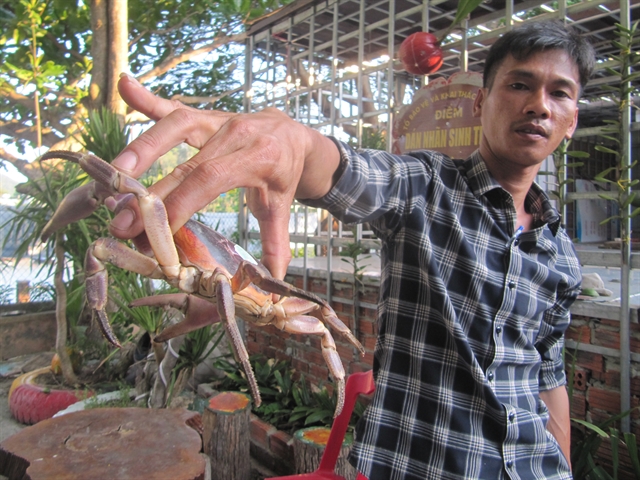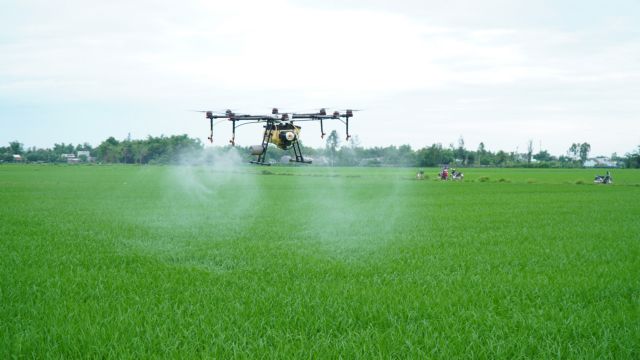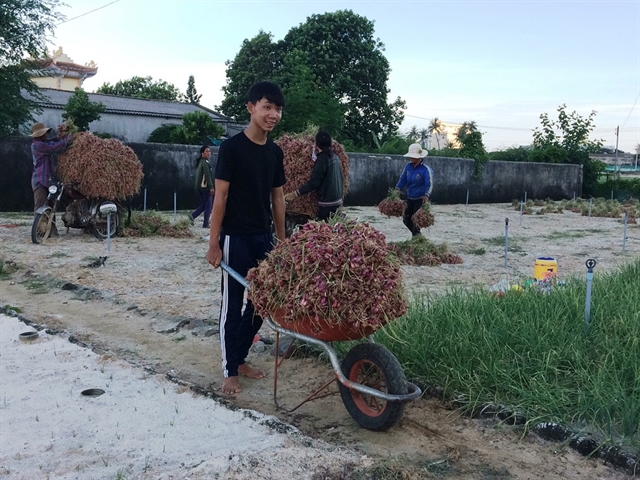 Society
Society

While the COVID-19 pandemic has devastated the tourism industry and hit industrial production hard, agriculture and community-based agro-forest production have proven resilient in the tourism-intensive central region.

|
| A woman in Thanh Đông Village collects vegetables at an organic farm near Hội An. VNS Photo Công Thành |
Công Thành
CENTRAL REGION — While the COVID-19 pandemic has devastated the tourism industry and hit industrial production hard, agriculture and community-based agro-forest production have proven resilient in the tourism-intensive central region.
Despite an average reduction at 30 per cent of revenue, farmers in suburban Đà Nẵng, Quảng Nam and Quảng Ngãi have maintained stable incomes compared to other sectors thanks to food chain distribution channels.
Traditional fishing and self-sufficient farm production have helped residents in the Chàm Islands off the coast of Hội An, the Lý Sơn Islands off Quảng Ngãi Province and gardeners in rural areas of Cẩm Thanh Commune in Hội An and Hòa Ninh and Túy Loan villages in Đà Nẵng keep going throughout the pandemic.

|
| An islander in the Chàm Islands catches a land crab for sale. The sustainable exploitation of seafood on the islands has created a stable income for local residents. VNS Photo Công Thành |
Restaurants, cafes and souvenir shops in Hội An – the most popular tourist destination in central Việt Nam – have closed, but farmers in organic gardens in Cẩm Thanh are still supplying people in Hội An and Đà Nẵng.
“Our organic-based gardener group still provide from 50kg to 70kg of fresh vegetables to local markets each day during the COVID-19 time. We even opened a new 1ha gardening zone in the commune for growing high yield crops and cash beans and nuts,” said the head of Hội An’s Thanh Đông organic cooperative, Lê Nhượng.
“Tourism service in the ancient town completely collapsed after four waves of the coronavirus pandemic and we also suffered a 50 per cent reduction of income from tourist arrivals and lower orders from the local market,” he explained, adding floods and torrential rains last year also damaged the farm.
He said homegrown rice and garden products have helped the farm’s 10 members keep going even as COVID-19 cuts their income.

|
| A UAV sprays pesticide on a rice farm in Quảng Nam Province. Photo courtesy of Minh Nhâm |
Nhượng said the farm used to host 3,000 visitors per year, but had lost at least US$29,000 from the impact of the pandemic on tourism.
Temporary solutions
Meanwhile, the Chàm Islands, 20km off the coast of Hội An, have been quiet since the start of the COVID-19 outbreak.
The islands, a core zone of the Hội An-Chàm Islands world biosphere reserve site, had annual revenue of VNĐ35 billion ($1.5 million) from visit tickets, but this figure has dropped to nearly zero.
Homestays, hotels, guides, motorbike rental shops, restaurants and boat services have all suffered as the number of visitors has slowed to a trickle.
Huỳnh Thị Thùy Hương from Chàm Islands Marine Area Protected managing board, said people working in the tourism and service sector had switched to make a living from fishing.
A report from the islands’ People’s Committee revealed that Chàm Islands, with a population of 2,400 earned $3.6 million, of which 65 per cent was from eco-tourism, per year pre-pandemic.
Nguyễn Thị Vân, who owns Vân Đức homestay, said in the past she could earn at least $18 from a tourist for her room and food service, but that's no longer the case.
She said her husband, who worked as a diving tour guide, had started fishing from a small boat to provide seafood for their family to eat.
Hương said 80 per cent of the population had previously left the fishing industry to get involved in tourism, so they had sold their fishing boats and fishing equipment.
She said small boat fishing is only a temporary solution to ease difficulties amid COVID-19 and they all want tourism to recover soon.
Trần Quý Tây, an official from the Chàm Islands’ People’s Committee, said some seafood agents on the islands had stayed in business by moving their trading online.
He said cargo ships help transport seafood from the islands to online buyers on the mainland and the seafood supply chain has not been interrupted during the pandemic, and no infections had been reported on the islands.
Off the coast of Quảng Ngãi Province, Lý Sơn Islanders have also been hit hard by the consequences of COVID-19.
More than 1,000 people working in tourism became unemployed, while transport – a key service between the islands and mainland – only saw revenue of VNĐ32 million ($1,300) from passengers and cargo in the first six months of 2021.
The islands hosted around 39,000 visitors in the first half of the year, a steep drop from 265,000 in 2019.
Chairwoman of the Islands’ People’s Committee, Phạm Thị Hương, said purple onion and garlic – the major breadwinner for the population of 22,000 – had a bumper harvest of 22 tonnes in the first half-year crop, but the price fell to VNĐ20,000 ($0.8) per kilo, a fifth of the previous price.
She said COVID-19 had limited the number of trips between the islands and mainland and demand for farm produce on the mainland had fallen due to widespread income reductions.
Quảng Ngãi Province has started social distancing as the number of SARS-COV-2 infections topped 100 in two weeks.
The islands, which have yet to record a case, are also closed to all trips.
Lê Văn Sơn, a tour guide of the Sea Tour Quảng Ngãi travel agency, said tourism labourers had found odd jobs to keep food on the table.
He said the fishing season has not yet come, while tourism was closed.
'Most resilient sector'
Chu Mạnh Trinh, a community-based education expert, said COVID-19 was a big challenge for most sectors, but agriculture was the most resilient sector during the pandemic.
He said farmers consistently preserve the natural farming practices that help build sustainable outcomes to overcome the hardship of COVID-19.
He said fish, livestock, rice and garden products supply major necessities to downtown shops.
Trinh said agriculture and fisheries in coastal rural areas have proven their sustainable value during the pandemic over the last 18 months.
He said living costs in rural areas are lower than in towns, where tourism and industrial production were heavily interrupted by COVID-19, leaving thousands of people unemployed.
Nguyễn Quang Dũng, head of the Túy Loan Co-operative, in suburban Hòa Vang District of Đà Nẵng, said the cooperative's output had fallen 30 per cent due to COVID-19.

|
| A local farmer harvests purple onions from a farm on the Lý Sơn Islands, off the coast of Quảng Ngãi Province. Photo courtesy of Phương Hoa |
However, he said, farmers still supply 500kg of fresh vegetables to customers in Đà Nẵng and the central region daily.
Dũng said the members of the 45-farmer cooperative still earned VNĐ4 million ($173) each per month, down 25 per cent from before COVID.
He said the farm, under the Việt Nam Agriculture Practice (VietGAP)-Participatory Guarantee system (GPS), has not stopped production for a single day during the pandemic.
Although Đà Nẵng has been affected by all the four waves of COVID-19, rural farms in Hòa Bắc Commune have maintained supply to the city.
Đỗ Thị Huyền Trâm, manager of a community-based farmstay, said COVID-19 had limited travellers due to social distancing orders, but it could not break production.
“Each farmer in the commune can produce stable food from a minimum 500sq.m garden and 1,000sq.m rice farm. Only watermelon and sugarcane had a few difficulties in sales due to poor storage,” Trâm said.
She said farmers in the commune earned nothing from tourism during COVID-19, but farming ensures stable incomes.
According to the city’s General Statistics Office, said Đà Nẵng's economy enjoyed 4.99 per cent growth in the first six months of 2021 compared to the same period last year.
However, the unemployment rate in the first half of this year was 7.27 per cent. — VNS

|